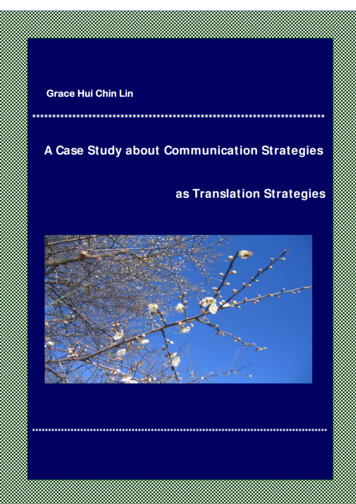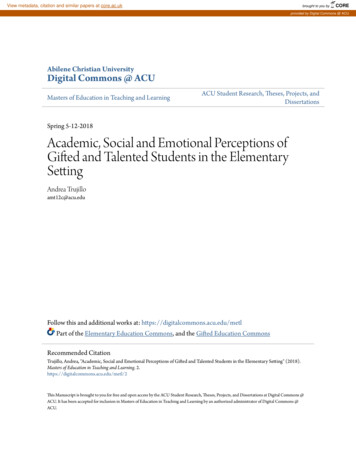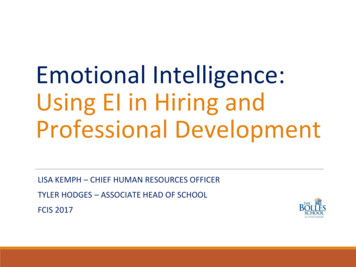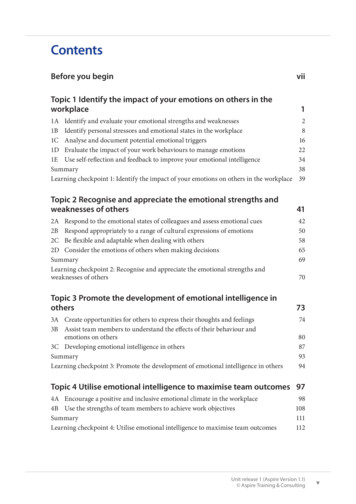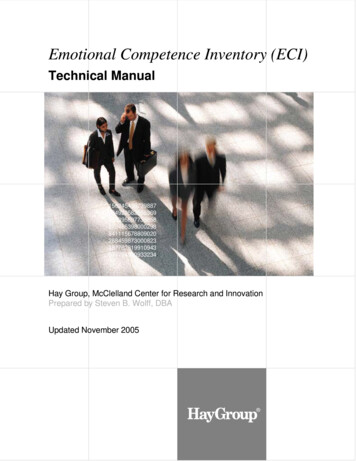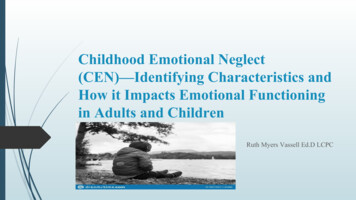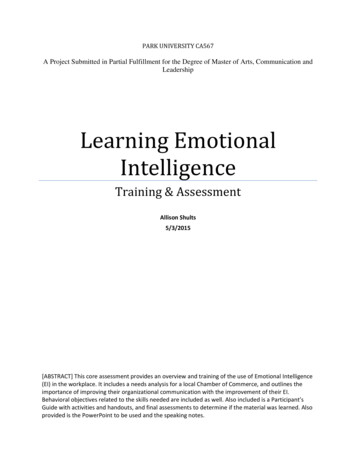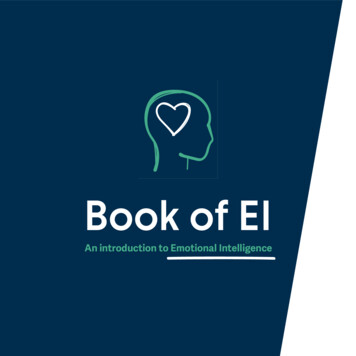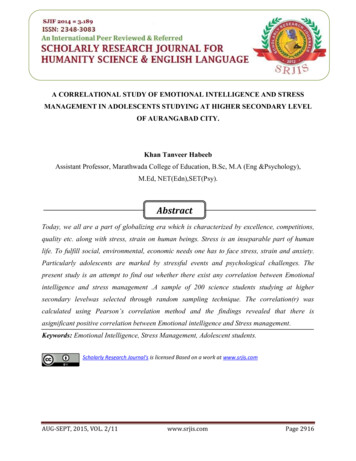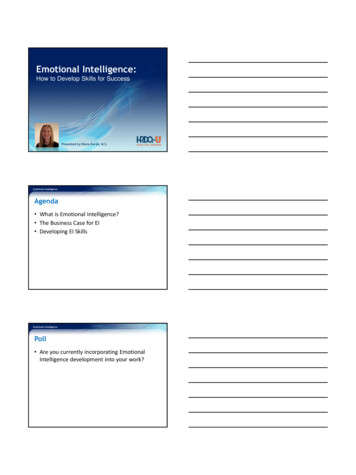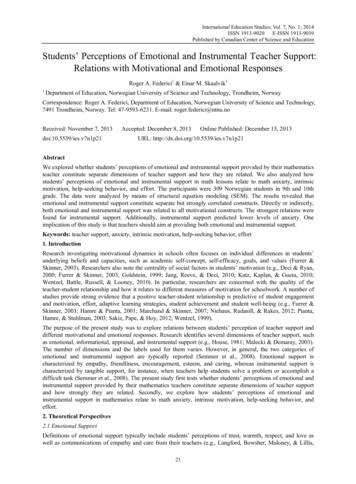
Transcription
International Education Studies; Vol. 7, No. 1; 2014ISSN 1913-9020E-ISSN 1913-9039Published by Canadian Center of Science and EducationStudents’ Perceptions of Emotional and Instrumental Teacher Support:Relations with Motivational and Emotional ResponsesRoger A. Federici1 & Einar M. Skaalvik11Department of Education, Norwegian University of Science and Technology, Trondheim, NorwayCorrespondence: Roger A. Federici, Department of Education, Norwegian University of Science and Technology,7491 Trondheim, Norway. Tel: 47-9593-6231. E-mail: roger.federici@ntnu.noReceived: November 7, 2013doi:10.5539/ies.v7n1p21Accepted: December 8, 2013Online Published: December 15, 2013URL: http://dx.doi.org/10.5539/ies.v7n1p21AbstractWe explored whether students’ perceptions of emotional and instrumental support provided by their mathematicsteacher constitute separate dimensions of teacher support and how they are related. We also analyzed howstudents’ perceptions of emotional and instrumental support in math lessons relate to math anxiety, intrinsicmotivation, help-seeking behavior, and effort. The participants were 309 Norwegian students in 9th and 10thgrade. The data were analyzed by means of structural equation modeling (SEM). The results revealed thatemotional and instrumental support constitute separate but strongly correlated constructs. Directly or indirectly,both emotional and instrumental support was related to all motivational constructs. The strongest relations werefound for instrumental support. Additionally, instrumental support predicted lower levels of anxiety. Oneimplication of this study is that teachers should aim at providing both emotional and instrumental support.Keywords: teacher support, anxiety, intrinsic motivation, help-seeking behavior, effort1. IntroductionResearch investigating motivational dynamics in schools often focuses on individual differences in students’underlying beliefs and capacities, such as academic self-concept, self-efficacy, goals, and values (Furrer &Skinner, 2003). Researchers also note the centrality of social factors in students’ motivation (e.g., Deci & Ryan,2000; Furrer & Skinner, 2003; Goldstein, 1999; Jang, Reeve, & Deci, 2010; Katz, Kaplan, & Gueta, 2010;Wentzel, Battle, Russell, & Looney, 2010). In particular, researchers are concerned with the quality of theteacher-student relationship and how it relates to different measures of motivation for schoolwork. A number ofstudies provide strong evidence that a positive teacher-student relationship is predictive of student engagementand motivation, effort, adaptive learning strategies, student achievement and student well-being (e.g., Furrer &Skinner, 2003; Hamre & Pianta, 2001; Marchand & Skinner, 2007; Niehaus, Rudasill, & Rakes, 2012; Pianta,Hamre, & Stuhlman, 2003; Sakiz, Pape, & Hoy, 2012; Wentzel, 1999).The purpose of the present study was to explore relations between students’ perception of teacher support anddifferent motivational and emotional responses. Research identifies several dimensions of teacher support, suchas emotional, informational, appraisal, and instrumental support (e.g., House, 1981; Malecki & Demaray, 2003).The number of dimensions and the labels used for them varies. However, in general, the two categories ofemotional and instrumental support are typically reported (Semmer et al., 2008). Emotional support ischaracterized by empathy, friendliness, encouragement, esteem, and caring, whereas instrumental support ischaracterized by tangible support, for instance, when teachers help students solve a problem or accomplish adifficult task (Semmer et al., 2008). The present study first tests whether students’ perceptions of emotional andinstrumental support provided by their mathematics teachers constitute separate dimensions of teacher supportand how strongly they are related. Secondly, we explore how students’ perceptions of emotional andinstrumental support in mathematics relate to math anxiety, intrinsic motivation, help-seeking behavior, andeffort.2. Theoretical Perspectives2.1 Emotional SupportDefinitions of emotional support typically include students’ perceptions of trust, warmth, respect, and love aswell as communications of empathy and care from their teachers (e.g., Langford, Bowsher, Maloney, & Lillis,21
www.ccsenet.org/iesInternational Education StudiesVol. 7, No. 1; 20141997; Patrick, Kaplan, & Ryan, 2011). Theoretically, one may distinguish between general and specificemotional support. General emotional support refers to students’ general perception of the teachers or of aparticular teacher as warm, friendly, encouraging, and accepting that students have different abilities. Specificemotional support refers to emotional support in particular situations, for instance, when a student is working ona difficult task or worry about not having friends in school. An inspection of the measures of emotional supportin the research literature reveals that the construct has almost entirely been measured as students’ generalperception of the teachers as warm and friendly (e.g., De Wit, Karioja, Rye, & Shain, 2011; Wentzel et al.,2010).Students’ perception of emotional support is related to their feeling of belonging, relatedness or connectedness(e.g., Marchand & Skinner, 2007). For instance, Furrer and Skinner (2003) measured students’ sense ofbelonging and relatedness using items that assessed their feeling of being accepted and appreciated by theteachers. Such measures differ from other measures of social support in that they do not ask students aboutteacher characteristics (e.g., being friendly) or what teachers do (e.g., care about students). Rather, they evaluatehow students feel when they are with their teachers.Although students’ perception of emotional support and feeling of relatedness may be conceptualized asdifferent constructs, one may assume that they are related. Theoretically, one may perceive belonging,relatedness, and safety as consequences of emotional support, whereas lack of emotional support in anachievement context may result in lower levels of belonging and higher levels of anxiety. The resultant feelingof belonging, relatedness, and safety may partially explain the impact of emotional support on students’motivation and well-being. For instance, Baumeister and Leary (1995) assert that feeling of belonging is afundamental need and that all individuals are inherently motivated to connect with others and form social bonds.They emphasizes that negative outcomes (e.g., psychological distress) may occur when individuals are notsocially connected, providing support for the argument that feeling of belonging is not only desired, but needed(Baumeister & Leary, 1995; Niehaus et al., 2012). Similarly, educational researchers within theself-determination perspective emphasize the importance of students’ feeling of connectedness to school (e.g.,Deci & Ryan, 2000; Ryan & Deci, 2000, 2006). According to Martin and Dowson (2009), relatedness providesthe required emotional security that individuals need to actively explore and effectively address their worlds.Findings consistently indicate that positive perceptions of teachers as emotionally supportive are associated withpositive educational outcomes. For instance, previous research reveals positive associations with students’engagement (Patrick, Ryan, & Kaplan, 2007), academic initiative (Danielsen, Wiium, Wilhelmsen, & Wold,2010), intrinsic motivation (E. Skaalvik & S. Skaalvik, 2013; Wentzel et al., 2010), and higher self-esteem andlower levels of anxiety (De Wit et al., 2011). Moreover, students who feel emotionally supported are more likelyto expend effort (Goodenow & Grady, 1993; Wentzel, 1994), ask for help (Newman & Schwager, 1993), and useself-regulated learning strategies (Ryan & Patrick, 2001). Studies of belonging and relatedness also showpositive associations with students’ engagement (Furrer & Skinner, 2003) and help-seeking behavior (Marchand& Skinner (2007). Moreover, research indicates that students who perceive a positive school environment andshare positive relationships with their teachers tend to have higher grades (Crosnoe, Johnson, & Elder, 2004;Roeser, Midgley, & Urdan, 1996).Based on theory and previous research, we expected perceived emotional support in mathematics lessons to bepositively related to measures of motivation for mathematics and negatively related to math anxiety. Aninteresting question was whether the relations between emotional support and measures of motivation were, atleast partially, mediated by lower levels of anxiety.2.2 Instrumental SupportWhereas emotional support is characterized by students’ perceptions of trust, warmth, respect, and care,instrumental aspects are characterized by tangible support. One may therefore, refer to nurturing versusaction-facilitating support (Cutrona & Suhr, 1994; Semmer et al., 2008). Definitions of instrumental supporttypically include students’ perceptions of being provided with instrumental resources and practical help (Malecki& Demaray, 2003; Suldo et al., 2009). This may include teachers’ questioning, clarifying, correcting, elaborating,and modeling behaviors that contribute to understanding, problem solving or skill development (Malecki &Demaray, 2003). Such practical support is noted in various motivational theories, for instance, Bandura’s socialcognitive theory, which highlights the essential role of communication and modeling in promoting masteryexperiences and expectations, which again increases motivation and performance outcomes and decreasesanxiety (Bandura, 1977, 1997).Empirical studies indicate that students’ perceptions of instrumental support have consequences for their22
www.ccsenet.org/iesInternational Education StudiesVol. 7, No. 1; 2014motivation and functioning. For instance, a study of Suldo et al. (2009) investigated which types of perceivedsocial support were most strongly associated with middle school students’ subjective well-being. Instrumentalsupport was measured as the students’ perception of tangible support (e.g., “Teachers take time to help me learnto do something well.”). Regression analysis indicated that instrumental support predicted students’ subjectivewell-being (β .19). However, the evidence is mixed. For instance, Malecki and Demaray (2003) investigatedthe types of support that students most often perceived from different sources and the degree to which differenttypes of support were related to students’ social, behavioral, and academic outcomes. These researchers foundthat emotional, but not instrumental support was significantly related to academic outcomes.Despite the emphasis on instrumental support in motivational theories, a literature search indicates that empiricalstudies of students’ perception of instrumental support are not as prominent as those examining emotionalsupport. Moreover, there is mixed evidence regarding instrumental support and student outcomes. Also, there isa lack of consistency in the terminology used (e.g., instrumental or instructional support). According to Maleckiand Demaray (2003), much of the empirical evidence regarding the positive outcomes of teacher support hasbeen based on either global measures of teacher support or on measures emotional support (Malecki & Demaray,2003). Despite the lack of empirical research, we expected instrumental support to be positively related tomotivational constructs and negatively related to anxiety. Our expectations were based on social cognitive theory.From this perspective instrumental support increases mastery experience that is the most important source ofmastery expectations or self-efficacy. In turn, self-efficacy increases motivation and motivated behavior anddecreases anxiety.2.3 Motivational and Emotional ResponsesFour motivational and emotional constructs are included in the current study, namely, math anxiety, intrinsicmotivation for mathematics, help-seeking behavior in math lessons, and effort when working with mathematics.We perceive math anxiety as a general state anxiety. State anxiety is an emotional response that occursoccasionally, manifests itself in specific situations, has a relatively short duration, varies in intensity, andinvolves physiological reactions (Spielberger, 1972, 1979). In school it often occurs in test situations but can alsomanifest itself as a general anxiety when working with a particular subject, for instance mathematics. Whenstudents perceive their teachers as supportive, they are more likely to be interested in academic activities and lesslikely to be anxious (Baumeister & Leary, 1995; Wentzel, 1998; Yildirim, 2012). For instance, a study of Ahmedet al. (2010) revealed that perceived teacher support positively predicted students’ interest and enjoyment butnegatively predicted anxiety in mathematics. Also, the finding that anxiety is a significant negative predictor oflearning strategy and achievement in mathematics is robust (e.g., Lapointe, Legault, & Batiste, 2005; Metallidou& Vlachou, 2007). These findings indicate that students’ math anxiety may be influenced by the degree ofteacher support that they receive.Intrinsic motivation may be defined as the inherent pleasure and satisfaction derived from engaging in an activity(Deci & Ryan, 1985). Previous studies reveal that boys show higher intrinsic motivation for mathematics thangirls (Bezzina, 2010; S. Skaalvik & E. Skaalvik, 2004) and that intrinsic motivation is positively related to effort,help-seeking behavior, and performance and negatively related to state anxiety (e.g., Cecchini et al., 2001;Marchand & Skinner, 2007; S. Skaalvik & E. Skaalvik, 2004; Yildirim, 2012). A useful framework forunderstanding why students are intrinsically motivated in a particular domain, such as mathematics, isself-determination theory (Deci & Ryan, 1985, 2000; Ryan & Deci, 2000). The main postulate of the theory isthat social factors promote intrinsic motivation via satisfaction of individuals’ fundamental needs for autonomy,competence, and relatedness (Deci & Ryan, 2000). Teachers may stimulate these needs in a variety of ways. Forinstance, teachers’ emotional support may stimulate the students’ need for relatedness, thus increasing theirintrinsic motivation. Moreover, teachers’ instrumental support may stimulate both the need for competence andautonomy. Thus, we expected both emotional and instrumental support to predict intrinsic motivation, bothdirectly and indirectly through reduced math anxiety.Help-seeking is a behavioral self-regulatory strategy that includes cognitive, motivational, affective, and socialaspects (Sakiz, 2012). Given optimal challenge in school, all students will encounter difficulty in their work withmathematics and need guidance and feedback. Therefore, help-seeking complements the value of instruction(Karabenick, 2004; Karabenick & Sharma, 1994) and is an important self-regulatory strategy that contributes tostudent learning (e.g., Newman, 1998, 2000; Ryan, Gheen, & Midgley, 1998). Nelson-LeGall and Resnick (1998)maintain that help-seeking not only holds the potential of working through an immediate academic difficulty butalso contributes to the acquisition of skills and knowledge that can be used in subsequent learning situations. Bycontrast, the avoidance of seeking help when it is needed is counter-productive. It may result inmisunderstandings, lack of problem solving, and lack of important skills (Ryan et al., 1998; Searcy & Eisenberg,23
www.ccsenet.org/iesInternational Education StudiesVol. 7, No. 1; 20141992).According to Karabenick (2004), the process of seeking help is inherently social; therefore, features of thelearning context are especially relevant. One of the most direct social influences is the perceived receptivity ofteachers to requests for assistance, and how teachers respond is an essential determinant of whether students seekhelp (Karabenick, 2004; Newman & Goldin, 1990). The research literature supports the notion that teachersupport promotes students’ help-seeking. For instance, teacher behaviors such as caring, listening and showingconcern for students increase students’ tendency to seek academic help, especially in elementary and middleschool classrooms (e.g., Newman, 2002, 2008; Ryan et al., 1998). Moreover, Myers, Edwards, Wahl, and Martin(2007) found that instructor aggressive communication behaviors were negatively related to college students’willingness to ask questions, overt information seeking and engagement. Thus, we expect both emotional andinstrumental teacher support to predict students’ help-seeking behavior.We also expected teacher support to be positively related to students’ effort, both directly and indirectly throughintrinsic motivation (Sakiz et al., 2012). For instance, students who are motivated to learn should be willing toexpend effort to succeed (Pintrich & Schunk, 2008). Moreover, teachers who provide both emotional andinstrumental support likely make students feel that they are valued and respected, which in turn improves effort,academic values, and achievement. Especially for instrumental support, social cognitive theory notes that peoplewho are socially persuaded to believe in their ability exert greater effort on tasks than those who are notconvinced about their ability to master difficult situations (Bandura, 1977, 1997). Positive perceptions ofemotional and instrumental support should therefore lead to increased effort.3. Purpose of the Study and a Theoretical ModelOne purpose of the present study was to test whether students’ perceptions of the emotional and instrumentalsupport provided by their mathematics teacher constitute separate dimensions of teacher support and howstrongly they are related. Another purpose was to test a theoretical model of relations between the twoanticipated dimensions of teacher support and math anxiety, intrinsic motivation, effort, and help-seekingbehavior (Model 1, see Figure 1).Figure 1. Theoretical model of relations between the constructsThe theoretical model is based on the analyses and predictions presented above (see “Theoretical perspectives”).Both emotional and instrumental support provided by the math teachers were expected to be negatively related tomath anxiety. Moreover, both dimensions of teacher support were expected to be positively related to intrinsicmotivation, effort, and help-seeking behavior in mathematics, both directly and indirectly through math anxiety.Furthermore, we expected intrinsic motivation to be positively related to effort and help-seeking behavior.24
www.ccsenet.org/iesInternational Education StudiesVol. 7, No. 1; 20144. Method4.1 Participants and ProcedureParticipants in the present study were students from two middle schools (8th–10th grade) located in one of thelarge cities in Norway. A total of 309 students in ninth (34%) and tenth (66%) grade responded to the survey.The sample consisted of 48.2% males and 51.8% females. The data were collected by means of a questionnairethat was administered in the school classes by a research assistant.4.2 InstrumentsThe instruments in the present study were developed and administered in Norwegian. The items representtranslations into English. The response categories for all items except grades were provided on a 6-point scaleranging from “Absolutely disagree” (1) to “Absolutely agree” (6). A 6-point scale is often used at the middleschool and high school level, for example the Self Description Questionnaire (Marsh, 1990).Students’ perceptions of the teachers as emotionally supportive were measured by six items. The scale is anextended and modified version of a previously tested scale of emotional support (E. Skaalvik & S. Skaalvik,2013). Examples of items are as follows: “I feel that my math teacher cares about me”, “I feel that my mathteacher is friendly”, and “My math teacher makes me feel safe”. These items indirectly tap into students’ feelingof being liked, respected, and valued by the mathematics teacher, which Goodenow (1993) recognizes asimportant requirements of belonging. Thus, the scale may also be regarded as an indicator of the emotionaldimension of the teacher-student relationship as experienced by the students. Cronbach’s alpha for the scalewas .94.Instrumental support was measured by a seven-item scale that was developed for the purpose of the presentstudy. The scale focused on the students’ perceived instrumental support from their math teacher. Examples ofitems are as follows: “When there is something I do not understand in mathematics, my math teacher explains itwell for me”, “When I have problems with math, I get good help and guidance from my math teacher”, and “Mymath teacher helps me so that I understand the math problems”. Cronbach’s alpha for the scale was .95.Intrinsic motivation was defined as interest in working with or liking to work with mathematics. It was measuredby a six-item scale. Examples of items are as follows: “I like mathematics” and “Working with mathematics isfun”. The scale had a Cronbach’s alpha of 0.93.Math anxiety was measured by a five-item math anxiety scale with a Cronbach’s alpha of .87. The scale focuseson the emotionality dimension of anxiety. Examples of items in the scale are as follows: “I am tense inmathematics lessons”, and “I am nervous in mathematics lessons”.Help-seeking behavior was measured by four items. The items were derived from a previously tested scale forhelp-seeking behavior in mathematics (S. Skaalvik & E. Skaalvik, 2005). Examples of items are as follows: “Ifthere is something I do not understand in math, I ask the teacher for help”, “If I am working on a math problemthat I am not able to solve, I ask the teacher for advice”, and “In mathematics lessons, I do not ask for help evenif I do not understand the problem I am working with”. Cronbach’s alpha for the scale was .83.Effort was conceptualized as individual students’ feelings of working hard, doing their homework, and putting intheir best effort. It was measured by three items that represent a modified version of a previously tested scale (E.Skaalvik & S. Skaalvik, 2013). The items were as follows: “I always do my best when I am working withmathematics”, “I always do my homework in mathematics”, and “I often rush through my work in mathematics”.Cronbach’s alpha for the scale was .77.The students’ level of achievement in mathematics was indicated by their grades in the previous semester.Grades in Norwegian schools are given on a six-point scale ranging from 1-6, with the latter indicating thehighest possible grade.4.3 Data AnalysisThe data were analyzed by means of confirmatory factor analysis (CFA) and structural equation modeling (SEM)using the AMOS 20 program. We first tested two measurement models by means of CFA. The first modeldefined emotional and instrumental support as separate but correlated constructs, whereas the second modeldefined math anxiety, intrinsic motivation, effort, and help-seeking behavior as separate and correlatedconstructs. Secondly, we explored relations between the variables by means of structural equation modeling(SEM). SEM is a statistical methodology that takes a confirmatory approach to the analysis (Byrne, 2010). Inthis approach, a hypothesized model of relations between the constructs is tested statistically to determine theextent to which it is consistent with the data, which is referred to as the goodness of fit. If the goodness of fit is25
www.ccsenet.org/iesInternational Education StudiesVol. 7, No. 1; 2014adequate, the plausibility of the relations among the constructs is supported. To assess the model fit, we usedwell-established indices such as CFI, IFI, TLI, and RMSEA as well as chi-square test statistics. For the CFI, IFI,and TLI indices, values greater than .90 are typically considered acceptable and values greater than .95 indicate agood fit to the data (Byrne, 2010; Hu & Bentler, 1999). For well-specified models, a RMSEA of .06 or lessreflects a good fit (Hu & Bentler, 1999; Tabachnick & Fidell, 2007).5. Results5.1 Correlations and Descriptive StatisticsTable 1 shows correlations between the study variables and maximum possible scores, statistical means, standarddeviations, and Cronbach’s alphas. Boys had higher intrinsic motivation for mathematics than girls. Grades orlevel of performance in mathematics were negatively related to math anxiety and positively related to perceivedteacher support and to the motivational constructs. Students’ perceptions of emotional and instrumental supportwere strongly correlated (r. .80). The three motivational variables, intrinsic motivation, effort, andhelp-seeking behavior, were moderately correlated (between .38 and .41). Math anxiety was not significantlyrelated to effort but was significantly and negatively related to all other variables in the study. Both emotionaland instrumental support were positively related to intrinsic motivation, effort, and help-seeking behavior.Table 1. Zero order correlations and descriptive statistics of the study variablesVariable1. Gender12345678-2. Grades in mathematics.057-3. Emotional 4. Instrumental support5. Intrinsic motivation6. Math anxiety7. Help-seeking behavior8. -.136.253**.234**-.131-Maximum possible score26364236302418Number of ard deviation-1.177.238.658.626.465.113.67Cronbach’s alpha--.94.95.93.87.83.77Note: * p .05, ** p .01.The estimates are based on observed data. Females are coded 1 and males are coded2.5.2 Measurement ModelsThe factor structure of teacher support was investigated by testing two measurement models by means ofconfirmatory factor analyses. The first model consisted of one primary factor with loadings on all 13 observeditems. Based on the strong correlation between emotional and instrumental support, this model was tested toascertain whether teacher support could be treated as a one-dimensional construct. The second defined twocorrelated primary factors corresponding to the two theoretical dimensions. None of the error variances in themodels were allowed to correlate. The first model did not fit the data well (χ2 (65, N 309) 624.63, p .001,CMIN/DF 9.610, RMSEA 0.167, IFI 0.869, TLI 0.816, and CFI 0.868). The second model had betterfit to the data than model 1 (χ2 (64, N 309) 186.27, p .001, CMIN/DF 2.911, RMSEA 0.079, IFI 0.971, TLI 0.959, and CFI 0.971), and all regression weights in the model were significant at p .001. Thecorrelation between the two latent teacher support variables was .828. Hence, the results from the confirmatoryfactor analyses support the conceptualization of two separate but strongly correlated teacher support constructs.We also tested a measurement model that included the motivational and emotional constructs by means of26
www.ccsenet.org/iesInternational Education StudiesVol. 7, No. 1; 2014confirmatory factor analysis. The model defined four correlated primary factors with corresponding items(Figure 2). None of the error variances in the model were allowed to correlate. The model had good fit to thedata (χ2 (129, N 309) 237.79, p .001, CMIN/DF 1.843, RMSEA 0.052, IFI 0.972, TLI 0.963, andCFI 0.972), and all regression weights in the model were significant at p .001. The correlations between thevariables were moderate (see Figure 2). Supporting the zero-order correlations (see Table 1), the confirmatoryfactor analysis also revealed a non-significant correlation between math anxiety and effort. The result supportsthe conceptualization of four separate but moderately correlated constructs.Figure 2. Measurement model of math anxiety, intrinsic motivation, effort, and help-seeking behavior5.3 Relations between Teacher Support and the Motivational and Emotional ConstructsThe relations between the variables were further investigated by means of structural equation modeling. We firsttested the theoretical model displayed in Figure 1. The model (referred to as Model 1) defined emotional andinstrumental support as exogenous variables. These variables were expected to be negatively related to mathanxiety. Moreover, they were expected to be positively related to intrinsic motivation, effort, and help-seekingbehavior, both directly and indirectly through math anxiety. In the model specification, none of the errorvariances were allowed to correlate. The model had acceptable fit to the data (χ2 (420, N 309) 807.33, p .001, CMIN/DF 2.922, RMSEA 0.055, IFI 0.954, TLI 0.945, and CFI 0.954). Estimates of bothunstandardized and standardized regression weights for all of the variables and the squared multiple correlationsare presented in Table 2. Math anxiety was not significantly predicted by either emotional or instrumentalsupport. Instrumental support predicted intrinsic motivation, effort, and help-seeking behavior positively anddirectly. It was particularly strongly related to intrinsic motivation, moderately related to help-seeking behavior,and weakly related to effort (standardized regression coefficients .491, .343, and .170, respectively). However,instrumental support was also indirectly related to effort (indirect effect .196) and help-seeking behavior(indirect effect .132). The indirect relations were mediated by intrinsic motivation. By contrast, emotionalsupport was not significantly related to any of the motivational constructs.27
www.ccsenet.org/iesInternational Education StudiesVol. 7, No. 1; 2014Table 2. Summary of SEM analysis of Model 1 including both emotional and instrumental supportLatent variableUnstandardizedregression weightsStandardizedregression weightsSEMath anxiety.019Instrumental support-.104-.093.133Emotional support-.061-.049.151Intrinsic motivat
emotional support. General emotional support refers to students' general perception of the teachers or of a particular teacher as warm, friendly, encouraging, and accepting that students have different abilities. Specific emotional support refers to emotional support in particular situations, for instance, when a student is working on
